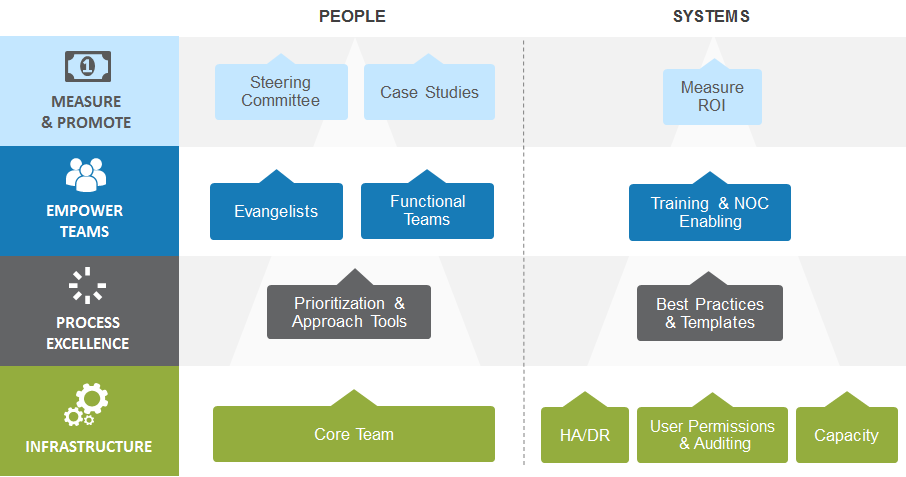
An estimated 30 to 40 percent of initial robotic process automation (RPA) projects fail to meet expectations. With any technology promising transformative change—whether RPA or AI—failures are going to happen. But with the right amount of planning, expectation setting, and strategic execution, failed RPA projects can be set back on the right track or avoided altogether.
No matter where you are on your RPA journey—whether you’re just starting or are scaling across new departments—here are the four most common ways RPA projects fail and how to avoid them.
1. Targeting the Wrong RPA Process
When you first hear about the benefits of automation—like increased productivity and efficiency, decreased errors and wasted time—it’s tempting to want to jump right in and automate everything. But starting too big is an easy way to fail. Not every process is built for RPA, at least not when you’re just getting started. Start small with a process that will give you a quick RPA ROI and prove the value of your RPA tool.
These processes to automate are typically more structured and highly repetitive. Ask yourself these questions as you determine the lowest hanging fruit that can give you the highest results:
- How much employee time will RPA save us on the process?
- How often does the process run?
- Is the process rule based, and does it utilize standard or structured data?
For more automation inspiration, see how other companies have used RPA from Automate to solve their IT and business problems.
Download The Automate Use Case Guide
2. Not Having an RPA Business Case
Identifying the right processes to automate is just the first step in a successful RPA implementation. Developing your RPA business case will lay the foundation for proving your success. Now that you know what process you’re going to automate, if you don’t already have an RPA solution, you can begin an RPA trial. Trying out an RPA tool gives you a chance to test your use case for free before you dive in. It also helps you find the right vendor that will best fit your needs and scale alongside you as your RPA footprint grows.
Choosing the right vendor can increase your ROI and further help you make the case for buying RPA software. Look for vendors that can help with end-to-end support that will be there for you beyond initial implementation. Vendors with no-code RPA solutions help get even your least code-savvy users up to speed and building automation. And also look for vendors with pre-built actions and automation connectors that further speed up the implementation process.
The most important step in creating a business case is defining your ROI metrics and documenting how your pilot use case worked. You’ll want to assess the following for your business case:
- Examine how well the automated process worked—or didn’t
- Document what went well and what can be improved
- Document the cost of implementation, deployment, and maintenance
- Document how much time is saved, any improvements in accuracy, and the amount of human intervention required
Being able to have solid data to compare before and after implementing an RPA solution will help you decide if you want to move forward with RPA—and help you gain approval of key stakeholders.
3. Underestimating Change Management
While it’s obviously most important to get the buying team on board with an RPA solution, you can’t underestimate the importance of getting buy in from the rest of your team. RPA is a disruptive technology, and with that disruption comes change. And you can't have change without managing it. When people hear “automation,” it can often come with fears of being replaced. But human employees are the backbone of RPA, and the technology is aimed at giving more time back for strategic work.
Managing the change comes down to building a culture of automation by communicating exactly why it’s happening and how it’s going to happen. Having great communication from top down—and even from bottom up—allows the entire company to roll with the punches as you move through the RPA journey. Ensuring that everybody knows what’s going on with automation, and why you’re doing it, builds a culture where everyone can rally around the concept of RPA itself.
4. Lack of RPA Governance Model
Part of building a culture of automation is implementing a proper governance model. This is done by creating an automation center of excellence (COE) framework. A COE brings together the people, processes, and technology necessary to create an overarching RPA strategy that is treated as an ongoing project. A great RPA solution brings together the disparate systems and applications across your business, and your COE ensures that everyone is on the same page, using the same processes, thus avoiding islands of automation. Your COE should focus on the following:
- Building a foundation for optimal performance
- Strategies for connectivity and integration
- Configuring bot and workflow templates that scale
- Documenting technical best practices, capacity planning, and analytics
Avoid RPA Pitfalls and Start Building an Automation CoE
For more best practices for strategic, scalable automation, read our guide that covers everything you need to know about creating your automation COE.